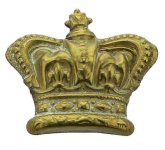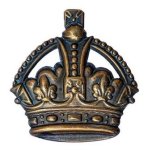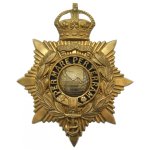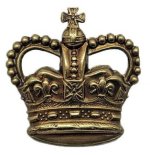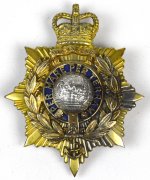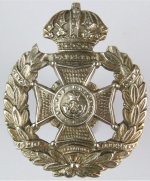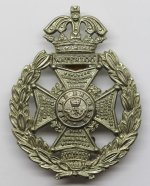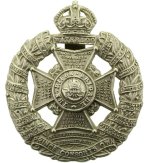Yeohelmetguy
Well-known member
Hello Forum Members,
As primarily a collector of Victorian and Edwardian British military headdress, as a sub-set of my British collection I maintain a very small collection of the same period Canadian military headdress. Another new addition to that small collection is a Canadian made Victorian 1861-1869 pattern other-ranks shako to the . The shako is excellent condition, of cork construction covered in “rifle green” cloth with black patent-leather bindings and front bill. The front of the shako is adorned with a black painted bronze regimental pattern badge and the shako is topped with a black cock's feather plume. The interior is marked “9B” indicating it is a pre-1900 shako since the Voltigeurs de Quebec did not become a regiment size entity until 1900 when most Canadian Militia battalions transformed into regiment size organizations.
Les Voltigeurs de Québec were formed in Quebec City, Quebec on 7 March 1862 as the 9th Battalion, Volunteer Militia Rifles, Canada (or "'Voltigeurs of Quebec'"). It was redesignated the 9th Regiment Voltigeurs de Québec on 8 May 1900, and, following the Great War, Les Voltigeurs de Québec on 29 March 1920. During the Second World War it was designated the 2nd (Reserve) Battalion, Les Voltigeurs de Québec on 10 May 1941 and Les Voltigeurs de Québec (Reserve) on 15 September 1944. After the Second World War it was designated Les Voltigeurs de Québec (Motor) on 1 April 1946. On 1 September 1954, it was amalgamated with Le Régiment de Québec (Mitrailleuses) and redesignated Les Voltigeurs de Québec (Mitrailleuses). It was, again, redesignated Les Voltigeurs de Québec on 11 April 1958. On 22 February 1965, the regiment was amalgamated with The Royal Rifles of Canada. The two regiments ceased to be amalgamated on 1 November 1966 and the “Voltigeurs de Quebec” continue as an active infantry regiment on the Canadian order of battle.
I hope you find this more unusual shako of interest… and thank you for looking at this post.
Cheers,
David
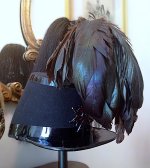
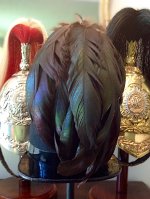
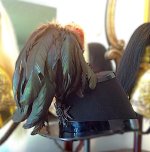
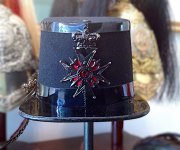
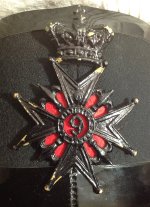
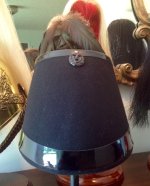

As primarily a collector of Victorian and Edwardian British military headdress, as a sub-set of my British collection I maintain a very small collection of the same period Canadian military headdress. Another new addition to that small collection is a Canadian made Victorian 1861-1869 pattern other-ranks shako to the . The shako is excellent condition, of cork construction covered in “rifle green” cloth with black patent-leather bindings and front bill. The front of the shako is adorned with a black painted bronze regimental pattern badge and the shako is topped with a black cock's feather plume. The interior is marked “9B” indicating it is a pre-1900 shako since the Voltigeurs de Quebec did not become a regiment size entity until 1900 when most Canadian Militia battalions transformed into regiment size organizations.
Les Voltigeurs de Québec were formed in Quebec City, Quebec on 7 March 1862 as the 9th Battalion, Volunteer Militia Rifles, Canada (or "'Voltigeurs of Quebec'"). It was redesignated the 9th Regiment Voltigeurs de Québec on 8 May 1900, and, following the Great War, Les Voltigeurs de Québec on 29 March 1920. During the Second World War it was designated the 2nd (Reserve) Battalion, Les Voltigeurs de Québec on 10 May 1941 and Les Voltigeurs de Québec (Reserve) on 15 September 1944. After the Second World War it was designated Les Voltigeurs de Québec (Motor) on 1 April 1946. On 1 September 1954, it was amalgamated with Le Régiment de Québec (Mitrailleuses) and redesignated Les Voltigeurs de Québec (Mitrailleuses). It was, again, redesignated Les Voltigeurs de Québec on 11 April 1958. On 22 February 1965, the regiment was amalgamated with The Royal Rifles of Canada. The two regiments ceased to be amalgamated on 1 November 1966 and the “Voltigeurs de Quebec” continue as an active infantry regiment on the Canadian order of battle.
I hope you find this more unusual shako of interest… and thank you for looking at this post.
Cheers,
David








